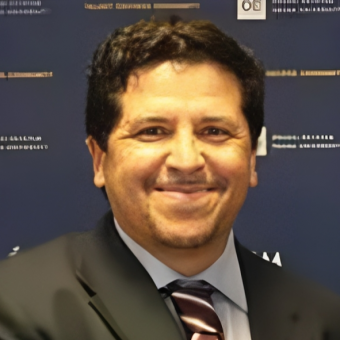
Prof. Habib Zaidi
Head of the PET Instrumentation & Neuroimaging Laboratory at Geneva University Hospital
Speech Title: Artificial Intelligence-Powered Multimodality Medical Image Analysis
Habib Zaidi is Chief physicist and head of the PET Instrumentation & Neuroimaging Laboratory at Geneva University Hospital and full Professor at the medical school of Geneva University. He is also a Professor of Medical Physics at the University of Groningen (Netherlands), Adjunct Professor of Medical Physics and Molecular Imaging at the University of Southern Denmark (Denmark), Adjunct Professor of Medical Physics at Shahid Beheshti University visiting Professor at Tehran University of Medical Sciences and Distinguished Professor at Óbuda University (Hungary). He is actively involved in developing imaging solutions for cutting-edge interdisciplinary biomedical research and clinical diagnosis. His research is supported by the EEC, Swiss National Foundation, EEC, private foundations and industry (Total >10M US$) and centres on hybrid imaging instrumentation (PET/CT and PET/MRI), deep learning for various imaging applications, modelling medical imaging systems using the Monte Carlo method, development of computational anatomical models and radiation dosimetry, image reconstruction, quantification and kinetic modelling techniques in emission tomography as well as statistical image analysis, and more recently on novel design of dedicated PET and PET/MRI scanners. He was guest editor for 13 special issues of peer-reviewed journals dedicated to Medical Image Segmentation, PET Instrumentation and Novel Quantitative Techniques, Computational Anthropomorphic Anatomical Models, Respiratory and Cardiac Gating in PET Imaging, Evolving medical imaging techniques, Trends in PET quantification (2 parts), PET/MRI Instrumentation and Quantitative Procedures and Clinical Applications, Nuclear Medicine Physics & Instrumentation, and Artificial Intelligence and serves as founding Editor-in-Chief (scientific) of the British Journal of Radiology (BJR)|Open, Deputy Editor for Medical Physics, and Associate Editor or member of the editorial board of the Journal of Nuclear Cardiology, Clinical Nuclear Medicine, Physica Medica, International Journal of Imaging Systems and Technology, Clinical and Translational Imaging, American Journal of Nuclear Medicine and Molecular Imaging, Brain Imaging Methods (Frontiers in Neuroscience & Neurology), Cancer Translational Medicine and the IAEA AMPLE Platform in Medical Physics. He has been elevated to the grade of fellow of the IEEE, AIMBE, AAPM, IOMP, AAIA and the BIR and was elected liaison representative of the International Organization for Medical Physics (IOMP) to the World Health Organization (WHO) and Chair of Subcommittee on Part 1 Examination of the International Medical Physics Certification Board (IMPCB) and the Imaging Physics Committee of the AAPM in addition to being affiliated to several International medical physics and nuclear medicine organisations. He is developer of physics web-based instructional modules for the RSNA and Editor of IPEM’s Nuclear Medicine web-based instructional modules. He is involved in the evaluation of research proposals for European and International granting organisations and participates in the organisation of International symposia and conferences. His academic accomplishments in the area of quantitative PET imaging have been well recognized by his peers and by the medical imaging community at large since he is a recipient of many awards and distinctions among which the prestigious 2003 Bruce Hasegawa Young Investigator Medical Imaging Science Award given by the Nuclear Medical and Imaging Sciences Technical Committee of the IEEE, the 2004 Mark Tetalman Memorial Award given by the Society of Nuclear Medicine, the 2007 Young Scientist Prize in Biological Physics given by the International Union of Pure and Applied Physics (IUPAP), the prestigious (100’000$) 2010 Kuwait Prize of Applied sciences (known as the Middle Eastern Nobel Prize) given by the Kuwait Foundation for the Advancement of Sciences (KFAS) for "outstanding accomplishments in Biomedical technology", the 2013 John S. Laughlin Young Scientist Award given by the AAPM, the 2013 Vikram Sarabhai Oration Award given by the Society of Nuclear Medicine, India (SNMI), the 2015 Sir Godfrey Hounsfield Award given by the British Institute of Radiology (BIR), the 2017 IBA-Europhysics Prize given by the European Physical Society (EPS), the 2019 Khwarizmi International Award given by the Iranian Research Organization for Science and Technology (IROST) and the 2023 John Mallard Award given by the IOMP for innovative developments of high scientific quality. Prof. Zaidi has been an invited speaker of over 160 keynote lectures and talks at an International level, has authored over 900+ publications (he is the senior or first author in a majority of these publications), including 395 peer-reviewed journal articles in high ranking journals, most of them in Q1/D1 of their categories (h-index=75, >20’300+ citations | Google scholar), 475 conference proceedings and 42 book chapters and is the editor of four textbooks on Therapeutic Applications of Monte Carlo Calculations in Nuclear Medicine (2 Editions), Quantitative Analysis in Nuclear Medicine Imaging, Molecular Imaging of Small Animals and Computational anatomical animal models.

